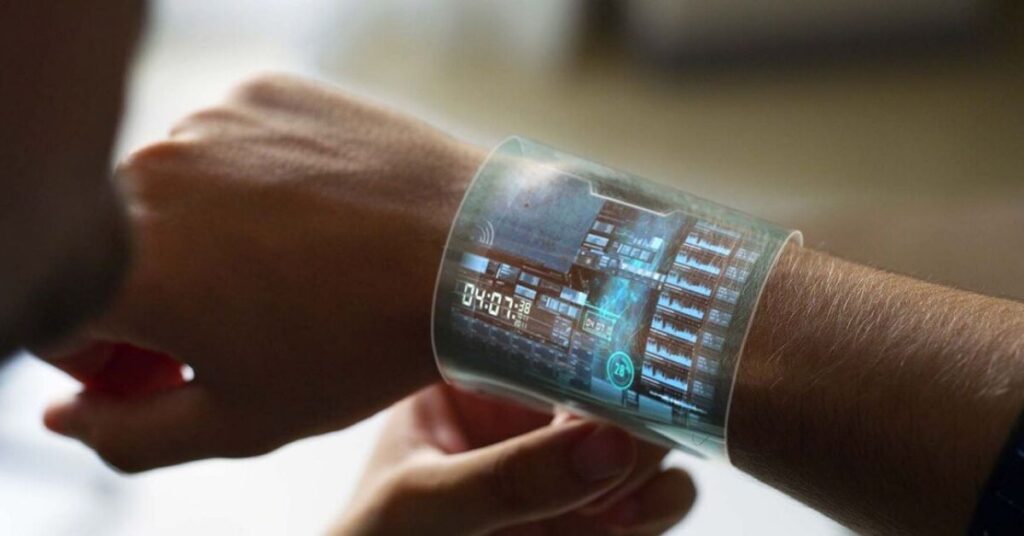Imagine a world where your smartphone can read your health, charge in seconds, and even change its shape to fit your needs. That future is not far away. Every year, technology giants push the limits of innovation, and what once seemed like science fiction is now becoming part of daily life. In this in-depth exploration of 12 Futuristic Features Coming Soon To Smartphones, we’ll look closely at the next wave of mobile advancements that are set to transform how we connect, work, and live in the U.S.
12. Photonic Crystal Displays
Smartphone displays have evolved rapidly—from LCD to OLED—but Photonic Crystal Displays are about to redefine screen technology. This futuristic feature uses microscopic structures to control light more efficiently, delivering sharper contrast, richer colors, and improved visibility under sunlight. Unlike traditional screens, photonic crystals bend and reflect light to produce color naturally, reducing the need for backlighting.
In practical terms, this means your phone’s battery will last longer while your display remains bright and vivid even outdoors. Researchers at MIT and companies like Samsung are already testing prototypes. In comparison to OLED, Photonic Crystal Displays promise up to 30% less power usage and double the lifespan.
| Display Type | Power Usage | Lifespan | Brightness in Sunlight |
| LCD | High | Medium | Poor |
| OLED | Medium | High | Moderate |
| Photonic Crystal | Low | Very High | Excellent |
If adopted widely, this innovation could mark the biggest display leap since Retina screens first appeared.
11. Nano-Tech Batteries
Among the 12 Futuristic Features Coming Soon To Smartphones, one that’s set to revolutionize the user experience is Nano-Tech Batteries. Battery life has always been a major pain point for smartphone owners, but that’s about to change. These next-generation batteries, built with nano-sized materials, can charge in minutes and last for days, far outperforming traditional lithium-ion ones.
Researchers at Stanford and other top U.S. universities are developing batteries that combine speed, efficiency, and sustainability. By coating nanowires with materials like silicon or graphene, they allow more ions to move freely without damaging the internal structure. This means smaller batteries that hold more energy—imagine plugging in your phone for just five minutes and having it powered all day long.
Beyond convenience, Nano-Tech Batteries will also make smartphones more eco-friendly by reducing electronic waste and dependence on heavy metals. In a fast-moving market like the U.S., where mobility and reliability matter most, this innovation could redefine how we think about smartphone power and performance.
10. Liquid Buttons
The era of physical buttons may soon return—but with a futuristic twist. Liquid Buttons are shape-shifting controls that appear when needed and disappear when not in use. Using microfluidic technology, the surface of your phone can raise tiny pockets of liquid that form tactile buttons for gaming, typing, or accessibility. When you’re done, the buttons flatten seamlessly back into the surface.
This innovation could make smartphones more flexible and user-friendly. For users with disabilities or those who love the feel of real buttons, Liquid Buttons offer a perfect blend of touch and technology. Imagine pressing a soft, raised button that responds instantly to pressure without the risk of damage or dust buildup. Several prototypes have been developed by tech startups in California, signaling a future where smartphone design becomes more organic and adaptive.
9. Headphone Surround Sound
Among the 12 Futuristic Features Coming Soon To Smartphones, one of the most exciting upgrades for entertainment lovers is Headphone Surround Sound. Imagine slipping in your earbuds and feeling like you’re inside a movie theater. Future smartphones will use spatial audio and AI-powered sound mapping to analyze your surroundings and adjust sound output, creating a rich, 360-degree listening experience.
For example, when you watch a movie during your daily commute, you’ll hear every sound as if it’s coming from different directions—the footsteps behind you, the dialogue in front, and the music all around. Technologies like Dolby Atmos and Apple Spatial Audio are already giving us a glimpse of this immersive future, but upcoming smartphones will take it a step further by personalizing sound based on your ear shape and movement.
Gamers, podcasters, and audiophiles in the U.S. will love how Headphone Surround Sound turns everyday listening into an unforgettable experience. Whether you’re playing, streaming, or recording, your smartphone will deliver audio clarity and depth that rivals professional studio systems.
8. Biometric Authentication
Security and privacy have become critical in the smartphone era. Biometric Authentication is no longer limited to fingerprints and facial recognition. The next phase includes iris scanning, heartbeat patterns, and even brainwave signals to identify users uniquely. With these advancements, your phone becomes nearly impossible to hack.
Apple and Google are experimenting with biometric sensors that analyze your body’s unique biological signals. In the U.S., where online banking and digital ID verification are common, these methods could eliminate passwords altogether. A heartbeat signature, for instance, is as distinctive as a fingerprint but much harder to replicate.
| Biometric Type | Accuracy | Adoption Potential | Security Level |
| Fingerprint | High | Widely Used | Medium |
| Face Scan | High | Widely Used | High |
| Heartbeat ID | Very High | Emerging | Very High |
| Brainwave ID | Experimental | Future | Extreme |
As privacy concerns rise, Biometric Authentication represents the next big leap in personal data protection.
7. Virtual Reality
The line between digital and physical is fading fast, and Virtual Reality is at the heart of this transformation. Future smartphones will be designed to power VR and AR experiences without extra headsets or cables. Imagine attending a virtual concert or exploring a 3D museum using only your phone and smart glasses.
The combination of powerful processors and edge computing will enable immersive experiences right from your pocket. American developers are already building VR platforms for education, fitness, and real estate. For instance, realtors in New York are using VR-enabled phones to show homes to remote clients. As 5G and 6G networks expand, VR on smartphones will become smoother and more accessible than ever.
6. Graphene
Graphene is often called the “miracle material,” and for good reason. This single layer of carbon atoms is stronger than steel, lighter than aluminum, and an incredible conductor of electricity. Future smartphones built with Graphene will be more durable, thinner, and efficient.
By replacing silicon chips and aluminum bodies, graphene can drastically reduce overheating and extend battery life. American researchers predict that graphene smartphones could charge fully in under five minutes while remaining cool to the touch. It will also make foldable and transparent phones more practical.
The table below shows how graphene compares to traditional materials:
| Material | Weight | Conductivity | Durability |
| Silicon | Medium | Good | Moderate |
| Aluminum | Light | Average | Good |
| Graphene | Very Light | Excellent | Exceptional |
Graphene could very well be the backbone of the next smartphone revolution.
5. No SIM Cards
Among the 12 Futuristic Features Coming Soon To Smartphones, one of the most practical innovations is the complete shift toward No SIM Cards. The traditional SIM tray is becoming obsolete as eSIM and iSIM technologies take over. Instead of physically inserting a SIM card, your identity and carrier details are stored securely within the device, allowing instant activation and seamless switching between networks. This makes life far easier for frequent travelers, digital nomads, and remote professionals across the U.S.
Major American carriers like Verizon and AT&T are rapidly expanding eSIM support, while leading manufacturers are now embedding iSIMs directly into processors. This shift not only improves convenience but also enhances smartphone design by freeing up internal space—making room for larger batteries, more sensors, or slimmer bodies. Additionally, with no external SIM slot, phones gain better water resistance and security, as one of the most vulnerable hardware entry points disappears. The No SIM Cards revolution represents a major leap forward in smartphone evolution, pushing us closer to a fully digital and connected future.
4. Pressure-Sensitive Screens
Touchscreens are about to become smarter with Pressure-Sensitive Screens. These advanced displays can detect how hard you press, opening the door to new ways of interaction. Press lightly to preview an image, press firmly to open it. Artists can sketch with different stroke thicknesses just like on real paper.
Apple’s Force Touch and Huawei’s Pressure Touch are early examples, but the next generation will be even more accurate. In the U.S., this feature will enhance gaming and design apps, giving users precision control. It could also improve accessibility for those who struggle with small touch targets. Combined with haptic feedback, pressure-sensitive screens make interaction feel more natural and responsive.
3. Flawless Voice Interaction
Imagine speaking to your smartphone as naturally as talking to a friend. Flawless Voice Interaction is where AI meets communication. Future voice assistants will understand tone, intent, and emotion. You won’t have to repeat commands or use robotic phrasing.
Thanks to generative AI, smartphones will soon offer real conversations instead of one-line responses. You could ask your phone to summarize an email, plan a weekend trip, or even brainstorm ideas. As American users grow more reliant on digital assistants, this evolution will save time and simplify multitasking. The future smartphone will become a personal companion capable of understanding you better than ever.
2. Innovative Medical Apps
As part of the 12 Futuristic Features Coming Soon To Smartphones, health technology stands out as one of the fastest-growing trends in the U.S. Innovative Medical Apps are now moving beyond basic step counts and heart rate tracking. The next wave of smartphones will come equipped with built-in sensors capable of monitoring glucose levels, hydration, oxygen saturation, and even stress hormones in real time.
These cutting-edge apps will connect directly with healthcare providers, allowing instant data sharing and real-time diagnostics. Imagine your smartphone detecting early signs of dehydration or elevated blood pressure and alerting you before symptoms appear. Major tech brands like Apple, Fitbit, and Samsung are already collaborating with medical institutions to secure FDA-approved health features, paving the way for medically reliable smartphones.
In a country that’s increasingly focused on preventive healthcare, this innovation could turn every smartphone into a pocket-sized medical assistant—one that empowers users to take control of their well-being every single day.
1. Smart Cameras
Last but not least, the evolution of Smart Cameras continues to amaze users everywhere. Artificial intelligence is transforming photography by analyzing light, angles, and facial expressions in real time. The result? Perfect shots every time, even in low light.
Upcoming smartphones will include predictive framing, emotion detection, and multi-lens fusion for professional-quality images. Google’s Pixel and Apple’s iPhone already use computational photography, but future devices will push boundaries further. For social media creators in the U.S., this means effortlessly producing content that looks polished and cinematic. Cameras will no longer just capture moments—they’ll understand them.
May Also Read: UHD Vs HD What Is The Difference
Conclusion
As we look at these 12 Futuristic Features Coming Soon To Smartphones, one thing is clear: the smartphone is no longer just a gadget—it’s becoming an intelligent partner. From Photonic Crystal Displays and Nano-Tech Batteries to Smart Cameras and Innovative Medical Apps, the next generation of devices will seamlessly merge technology with human needs.
In the coming years, these breakthroughs will reshape industries, redefine daily life, and blur the boundaries between science and imagination. The future of smartphones isn’t simply about speed or style—it’s about smarter living in a connected world that’s always evolving.

Jake Miller is a mobile troubleshooting specialist with 7+ years of experience solving Android and app-related issues. He tests every fix on real devices to ensure accuracy and reliability. Jake creates simple, step-by-step guides to help users quickly resolve everyday smartphone problems.



